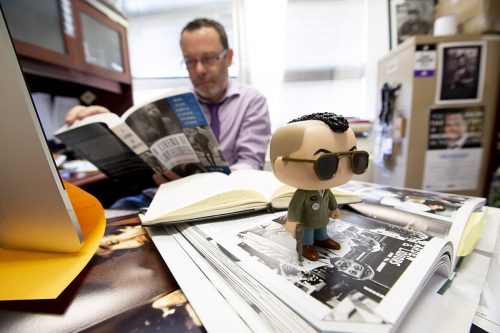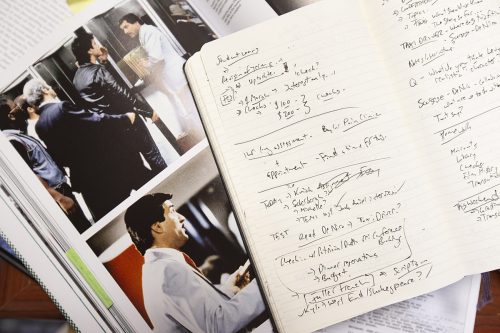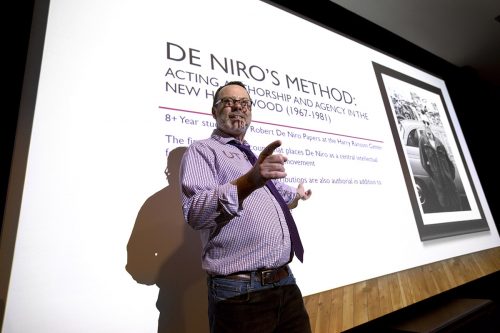‘De Niro Method’ Tracks Actor’s Evolving Career
Film scholar R. Colin Tait looks at five decades of artistic accomplishment and how a star can contribute to a director’s vision.

Film scholar R. Colin Tait has written books on director Steven Soderbergh and actor Robert De Niro. Photo by Joyce Marshall
‘De Niro Method’ Tracks Actor’s Evolving Career
Film scholar R. Colin Tait looks at five decades of artistic accomplishment and how a star can contribute to a director’s vision.
R. Colin Tait projected an excerpt from the script of Raging Bull for his Media Authorship class to see. The page was covered in Robert De Niro’s scratchy handwriting and crossed-out, rewritten lines for Martin Scorsese’s Oscar-winning 1980 film.
Tait, assistant professor of film, television and digital media, pointed out the rare phenomenon of an actor contributing to a film’s final script.
While a doctoral student at the University of Texas at Austin’s Moody College of Communication, Tait gained access to the school’s De Niro papers — scripts, costumes, notes and other materials spanning 50 years, from 1968’s Greetings to The Irishman, with an expected release in 2019.
Tait said he knew he was looking at a gold mine of film history. “I realized you could easily make a career just looking at this archive.”
The film researcher spent five years exploring the archives for his forthcoming book, De Niro’s Method: Acting, Authorship and Agency in the New Hollywood (1967-1983) (University of Texas Press, expected 2019).

R. Colin Tait calls this pop figure of Travis Bickle (from Taxi Driver) his muse and patron saint for the writing of his book. Photo by Joyce Marshall
Tait’s first full-length film theory book with co-author Andrew deWaard, The Cinema of Steven Soderbergh: Indie Sex, Corporate Lies, and Digital Videotape (Wallflower Press, 2013), is a treatise on the director of Ocean’s Eleven and Out of Sight fame.
The film scholar said he is drawn to transcendent film personalities not for their artistry, but rather for their craftsmanship and their status as laborers.
“We know a lot about artists … but we don’t know how to talk about craftsmen as much,” Tait said. “Understanding what they do … is really important to me.”
Perceiving De Niro as a complicated human being rather than as an actor, Tait said, galvanized his research on the actor’s career and its effects on the film industry. He said he wants people to appreciate the inquisitive, thoughtful man behind the violent brute he played in films such as Taxi Driver, Raging Bull and Goodfellas. “He’s not just an actor, but he’s an intellectual, he’s an academic. He researches better than I can.”
Tom Schatz, the Mary Gibbs Jones Centennial Chair of Radio-Television-Film at UT, called the De Niro collection “extremely useful,” adding that it “gets us closer to … the actual filmmaking process than anything short of observing a shoot.”
The documents reveal De Niro’s significant contributions behind the scenes, a key to Tait’s argument about his role beyond acting, Schatz said. Tait “found evidence to support De Niro’s extremely active role in the creative process.”

R. Colin Tait’s analysis of Robert De Niro’s career shows that the actor is a formidable writer. Photo by Joyce Marshall
Tait said De Niro’s script contributions were so substantial that he could have received writing credits. The actor’s unique authorship defies the auteur theory — the prevailing academic notion that the director is the most important creative force behind a film.
The film researcher said lionizing directors can contribute to the Hollywood power structures that have led to rampant sexual misconduct.
“The problem with auteur theory is that it’s a ‘great man’ theory … the artist as the lone poet,” Tait said. “I think we run into dangerous territory, like Harvey Weinstein … these figures who we allow these terrible excesses because we’re convinced of their genius.”
De Niro’s career taught Tait that an actor can be just as instrumental as a director. “If we can spread around the blame or credit a little bit, we’re less invested in needing that [director] figure, and therefore we are less willing to forgive them for those excesses.”
Video by Zach Martino
The film scholar also said De Niro’s chameleonic performances, from a damaged Vietnam veteran in 1978’s The Deer Hunter to an obsessed wannabe late-night host in 1982’s The King of Comedy, can illuminate changing ideas of masculinity in modern America.
Or “at least understanding that there are multitudes of men inside one man,” Tait said. “He’s not just known for a hostile, troubled killer, but there’s sensitive roles he plays as well.”
De Niro is perhaps most famous for his Raging Bull-type roles, and Tait said the actor’s films explore “overdetermined, toxic masculinity, but they also offer a critique of that by showing that there are other kinds of men that one could be.”
Tait pointed to De Niro’s close relationship with his father, Robert Sr., a painter who was gay, as “fundamental to the way that he thinks about masculinity and fatherhood.”
From the ’90s on, De Niro has portrayed fathers and grandfathers, as in Being Flynn and The Intern. Tait said this shift adds to the actor’s expanding representation of men. The film scholar describes these roles as “softer” and “sensitive … sort of father figures as opposed to someone who just beats people up.”

R. Colin Tait, assistant professor of film, lectures about Robert DeNiro’s history and influence on the film industry. Photo by Joyce Marshall
The De Niro files also have helped Tait understand the importance of archival research in film studies, which he said “has the potential to dislodge so many things that we already believe.” Research helps the film community better understand the history of its craft, Tait said.
De Niro’s career has evolved from movie star to full-time artistic contributor. De Niro’s intelligence has elevated him to accomplishments such as the Cecil B. deMille Award for lifetime achievement at the 2011 Golden Globes. He may be a shy actor famous for portraying savage men and goofy grandfathers, Tait said, “but that doesn’t mean he’s not an intellectual.”

Your comments are welcome
2 Comments
Mr. DeNiro is as serious about his acting as a surgeon may be about the next operation. In his eyes there is no wiggle room around the mark he wants to reach. It’s admirable not only for the serious value the actor places on the craft of acting but for the depth and range of his ability and talent. I enjoyed watching Marlon Brando, but he held no sense of value for the craft of acting; moreover, stating that acting was not a “socially redeemable” profession. Hence, his passion for the plight of the American Indian and Hollywood’s portrayal of them as uncivilized savages.A worthy cause, but It is acting and the genre of cinematic or stage storytelling that mirrors societies flaws, creates awareness and finally enlightenment.
Were it not for the meticulous work of actors like Mr DeNiro and directors such as Martin Scorsese, and the gift of their vision and awareness, generations to come would be missing a crucial link in the evolution of human intelligence and insight.
Joseph Leone josephleone60@gmail.com
Hey Joseph, can you elaborate a bit or suggest me a resource where I can find critical analysis of deNiro’s acting in his top films.TIA
Related reading:
Features
‘Come From Away’ Inspiration Beverley Bass Tells Her Story
An American Airlines pilot got diverted on 9/11, and her story has landed on Broadway.
Alumni
Ron Hall’s True Calling
An art dealer’s story of friendship takes on a life of its own as a movie, Same Kind of Different As Me, now in theaters.
Alumni
James Chase Sanchez’s Documentary Airs on PBS
Documentary filmmaker and alumnus wins an award for Man on Fire.